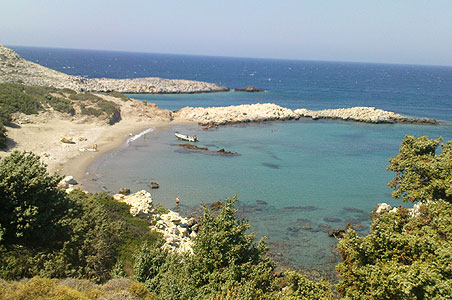You should know how to live to be 100 years old by now. Tip number one: inherit good genes. Tip number two: forget uploading your consciousness to an AI, for now. Tip number three: live and eat in a so-called Blue Zone. Tip number four: walk fast, eat slowly.
From the NYT:
Dan Buettner and I were off to a good start. He approved of coffee.
“It’s one of the biggest sources of antioxidants in the American diet,” he said with chipper confidence, folding up his black Brompton bike.
As we walked through Greenwich Village, looking for a decent shot of joe to fuel an afternoon of shopping and cooking and talking about the enigma of longevity, he pointed out that the men and women of Icaria, a Greek island in the middle of the Aegean Sea, regularly slurp down two or three muddy cups a day.
This came as delightful news to me. Icaria has a key role in Mr. Buettner’s latest book, “The Blue Zones Solution,” which takes a deep dive into five places around the world where people have a beguiling habit of forgetting to die. In Icaria they stand a decent chance of living to see 100. Without coffee, I don’t see much point in making it to 50.
The purpose of our rendezvous was to see whether the insights of a longevity specialist like Mr. Buettner could be applied to the life of a food-obsessed writer in New York, a man whose occupational hazards happen to include chicken wings, cheeseburgers, martinis and marathon tasting menus.
Covering the world of gastronomy and mixology during the era of David Chang (career-defining dish: those Momofuku pork-belly buns) and April Bloomfield (career-defining dish: the lamb burger at the Breslin Bar and Dining Room) does not exactly feel like an enterprise that’s adding extra years to my life — or to my liver.
And the recent deaths (even if accidental) of men in my exact demographic — the food writer Joshua Ozersky, the tech entrepreneur Dave Goldberg — had put me in a mortality-anxious frame of mind.
With my own half-century mark eerily visible on the horizon, could Mr. Buettner, who has spent the last 10 years unlocking the mysteries of longevity, offer me a midcourse correction?
To that end, he had decided to cook me something of a longevity feast. Visiting from his home in Minnesota and camped out at the townhouse of his friends Andrew Solomon and John Habich in the Village, this trim, tanned, 55-year-old guru of the golden years was geared up to show me that living a long time was not about subsisting on a thin gruel of, well, gruel.
After that blast of coffee, which I dutifully diluted with soy milk (as instructed) at O Cafe on Avenue of the Americas, Mr. Buettner and I set forth on our quest at the aptly named LifeThyme market, where signs in the window trumpeted the wonders of wheatgrass. He reassured me, again, by letting me know that penitent hedge clippings had no place in our Blue Zones repast.
“People think, ‘If I eat more of this, then it’s O.K. to eat more burgers or candy,’ ” he said. Instead, as he ambled through the market dropping herbs and vegetables into his basket, he insisted that our life-extending banquet would hinge on normal affordable items that almost anyone can pick up at the grocery store. He grabbed fennel and broccoli, celery and carrots, tofu and coconut milk, a bag of frozen berries and a can of chickpeas and a jar of local honey.
Advertisement
The five communities spotlighted in “The Blue Zones Solution” (published by National Geographic) depend on simple methods of cooking that have evolved over centuries, and Mr. Buettner has developed a matter-of-fact disregard for gastro-trends of all stripes. At LifeThyme, he passed by refrigerated shelves full of vogue-ish juices in hues of green, orange and purple. He shook his head and said, “Bad!”
“The glycemic index on that is as bad as Coke,” he went on, snatching a bottle of carrot juice to scan the label. “For eight ounces, there’s 14 grams of sugar. People get suckered into thinking, ‘Oh, I’m drinking this juice.’ Skip the juicing. Eat the fruit. Or eat the vegetable.” (How about a protein shake? “No,” he said.)
So far, I was feeling pretty good about my chances of making it to 100. I love coffee, I’m not much of a juicer and I’ve never had a protein shake in my life. Bingo. I figured that pretty soon Mr. Buettner would throw me a dietary curveball (I noticed with vague concern that he was not putting any meat or cheese into his basket), but by this point I was already thinking about how fun it would be to meet my great-grandchildren.
I felt even better when he and I started talking about strenuous exercise, which for me falls somewhere between “root canal” and “Justin Bieber concert” on the personal aversion scale.
I like to go for long walks, and … well, that’s about it.
“That’s when I knew you’d be O.K.,” Mr. Buettner told me.
It turns out that walking is a popular mode of transport in the Blue Zones, too — particularly on the sun-splattered slopes of Sardinia, Italy, where many of those who make it to 100 are shepherds who devote the bulk of each day to wandering the hills and treating themselves to sips of red wine.
“A glass of wine is better than a glass of water with a Mediterranean meal,” Mr. Buettner told me.
Red wine and long walks? If that’s all it takes, people, you’re looking at Methuselah.
O.K., yes, Mr. Buettner moves his muscles a lot more than I do. He likes to go everywhere on that fold-up bike, which he hauls along with him on trips, and sometimes he does yoga and goes in-line skating. But he generally believes that the high-impact exercise mania as practiced in the major cities of the United States winds up doing as much harm as good.
“You can’t be pounding your joints with marathons and pumping iron,” he said. “You’ll never see me doing CrossFit.”
For that evening’s meal, Mr. Buettner planned to cook dishes that would make reference to the quintet of places that he focuses on in “The Blue Zones Solution”: along with Icaria and Sardinia, they are Okinawa, Japan; the Nicoya Peninsula in Costa Rica; and Loma Linda, Calif., where Seventh-day Adventists have a tendency to outlive their fellow Americans, thanks to a mostly vegetarian diet that is heavy on nuts, beans, oatmeal, 100 percent whole-grain bread and avocados.
We walked from the market to the townhouse. And it was here, as Mr. Buettner laid out his cooking ingredients on a table in Mr. Solomon’s and Mr. Habich’s commodious, state-of-the-art kitchen, that I noticed the first real disconnect between the lives of the Blue Zones sages and the life of a food writer who has enjoyed many a lunch hour scarfing down charcuterie, tapas and pork-belly-topped ramen at the Gotham West Market food court.
Where was the butter? Hadn’t some nice scientists determined that butter’s not so lethal for us, after all? (“My view is that butter, lard and other animal fats are a bit like radiation: a dollop a couple of times a week probably isn’t going to hurt you, but we don’t know the safe level,” Mr. Buettner later wrote in an email. “At any rate, I can send along a paper that largely refutes the whole ‘Butter is Back’ craze.” No, thanks, I’m good.)
Where was the meat? Where was the cheese? (No cheese? And here I thought we’d be friends for another 50 years, Mr. Buettner.)
Read the entire article here.


 It’s safe to suggest that most of us above a certain age — let’s say 30 — wish to stay young. It is also safer to suggest, in the absence of a solution to this first wish, that many of us wish to age gracefully and happily. Yet for most of us, especially in the West, we age in a less dignified manner in combination with colorful medicines, lengthy tubes, and unpronounceable procedures. We are collectively living longer. But, the quality of those extra years leaves much to be desired.
It’s safe to suggest that most of us above a certain age — let’s say 30 — wish to stay young. It is also safer to suggest, in the absence of a solution to this first wish, that many of us wish to age gracefully and happily. Yet for most of us, especially in the West, we age in a less dignified manner in combination with colorful medicines, lengthy tubes, and unpronounceable procedures. We are collectively living longer. But, the quality of those extra years leaves much to be desired.